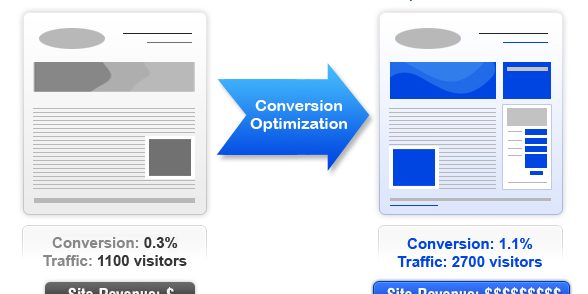Last year’s ‘Black Friday’ shopping holiday generated that day a total of $1.2 billion in sales. That’s a 15% increase from the year before. Shopping online is growing every year and online consumers have gotten accustomed to a certain set of standards.
E-commerce sites and online stores have to provide the experience that is expected by the consumers, if they want to sell and succeed. A brand and company that wishes to sell online must optimize several areas of the website for best chances at a sale. Consumers have a set of expectations when shopping online.
The average shopping cart drop out rate is 67.89% by comScore and there can be much done to minimize the numbers. E-commerce Conversion Optimization is the practice and process by which a business minimizes shopping cart abandonment and e-commerce site drop out rates.
Before any investments are made in paid search campaigns, display advertising, SEO or social media ads, it’s critical that the e-commerce website and shopping pages are optimized for conversion. A website can receive traffic, but if it is not optimized for conversion, a return on investment would be difficult to reach.
To improve the results for an e-commerce operation and website, here are tips that will help. Companies should keep in mind, turning shoppers into buyers’ starts with a quick glance at the homepage, which is the most popular landing page for a business.
10 E-commerce Conversion Optimization Tips
1. Responsive Design
In the past year mobile traffic has grown to 31.7 percent of all online traffic (IBM), if the shopping cart and e-commerce website isn’t mobile compatible through Responsive Design, a company should stop everything and fix this right away. Websites that are not Responsive Design (work across all major devices such as smart phones and tablets) will not suffice anymore moving forward with consumers. E-commerce conversion optimization starts with Responsive Design.
2. Prices and Shipping
44% of carts are abandoned because of high shipping costs, but the same study showed that 25% were abandoned because the product cost more than expected and 22% because shipping costs were listed too late in the process. So a full 91% of carts are abandoned for price or shipping related reasons. Pricing and shipping information is an influential factor in making a purchase decision and optimizing sales conversion.
3. Trust Factor
76.5% of shoppers on average state that a site has to look credible and trustworthy. It is an important factor in a shopper’s decision-making process to buy. An e-commerce website for best results should be professionally designed. Conversion optimization can be also improved by borrowing some credibility from trusted organizations such as Better Business Bureau (BBB) and other authority organizations.
4. Reviews and Testimonials
Featuring product reviews can improve sales by up to 18%. A study by Oneupweb showed that customer reviews and testimonials are considered an important purchasing factor by 40.9% of respondents. One of the fastest methods of improving e-commerce conversion optimization is displaying reviews and testimonials throughout a website, especially on shopping cart pages.
5. Website Home Page Incentives
Most people love to receive a deal, and when companies offer a percentage off certain items or seasonal discounts, free shipping, and so on, it improves sales conversion. E-commerce sites can create simple graphics that display special offer and place them strategically throughout the website. On the home page and dedicated landing pages, incentives should be well displayed with attractive looking call to action.
6. Reports and Testing
For e-commerce websites to be improved through conversion optimization and any other method, reports, analysis and testing is required. For a business to gain the understanding, certain tools must be utilized such as Google Analytics, Google Webmaster Central, and other third party tools. These allow a business to review all statistics necessary to make the proper adjustments.
7. Guarantees and Policies
Shoppers react positively to guarantees and honest trustworthy brand policies. E-commerce websites that clearly display their policies such as “Money Back Guarantee” or certain “Return Policies” improve sales conversion. Shoppers like to see well-displayed guarantees and policies in a clear and simple format.
8. Contact Ability and Information
Customer service is critical for improving conversion for e-commerce websites. Customers expect when using credit cards and shopping online to be able to contact someone from the website if necessary. A life person and well displayed contact information throughout the website is required for websites to have sales. Consumers want to see clearly a phone number, chat options, company address, and other methods of customer service such as email addresses and online forms.
9. E-commerce Website Design
Consumers understand the difference between simple template shopping websites and e-commerce websites that are more established. Even though online a smaller operation can level the playing field by using quality e-commerce website design, many don’t for economic reasons. To improve sales conversion for e-commerce websites, customized and professional quality website design should be used to create effective online stores and sites.
10. Active Sales Process
Companies that wish to be effective with e-commerce websites and online stores should have an active sales process. This means, there should be a structure in place to contact all shopping car abandoned site visitors. Customers should receive monthly newsletters including promotions and specials. Follow-up with all contacts, customers, and website visitors that leave their email address and so on.
Companies that wish to improve their e-commerce websites and online sales can look at all these areas and improve upon them. An organization may not have the right staff to make these improvements or simply does not have the time. These types of services are called Conversion Optimization, companies can hire professionals for it and also work through consulting services to get advice, information, and a consultation prior to allocating a budget.







